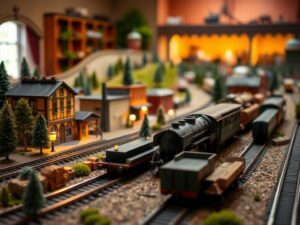How to Check and Maintain HO Scale Couplers
How to Check and Maintain HO Scale Couplers
How to Check and Maintain Your HO Scale Couplers
Welcome back, fellow railfans! Today, we’re diving into a topic crucial for keeping your HO scale trains running smoothly: coupler maintenance. Those little metal links that connect your rolling stock might seem insignificant, but they play a vital role in powering your miniature world. A faulty coupler can cause derailments, broken cars, and overall frustration, which is the opposite of the enjoyment model railroading should bring!
Don’t worry, this isn’t as complicated as re-wiring a locomotive. We’ll walk you through the essentials, covering everything from understanding how HO scale couplers work to troubleshooting common issues and even replacing worn-out ones. By the end of this blog post, you’ll be well on your way to becoming a coupler-connoisseur, ensuring your trains connect seamlessly and roll across your layout with confidence.
Understanding Your Coupler Arsenal
First things first: let’s talk about HO scale couplers. These are the connectors responsible for joining train cars together. They’re usually categorized into two main types:
* Janney Couplers: The standard design you’ll find on most pre-assembled rolling stock. They feature a drawbar mechanism, allowing cars to be pulled apart and linked back together easily. Think of it like the old metal couplers on your grandpaâs vintage pickup truck.
* Knapp Couplers: While less common than Janney, these are gaining popularity due to their realism and ability to represent different types of couplings used historically. They often offer finer detail and sometimes come in unique configurations.
Troubleshooting the Connection Crisis
Before we delve into maintenance, let’s address those dreaded coupler issues:
- Uncoupling Woes: Your trains are connected, but separating cars can be a struggle? The problem might lie with debris caught between the drawbars or binding parts caused by wear and tear. A simple cleaning often does the trick.
- Looseness Issues: Cars that separate during runs indicate loose coupling points. Inspect the knuckle of the coupler – if it’s bent, worn, or broken, replacement is needed.
- Shorter Than Usual Running Length: This could signal issues with cars failing to couple properly or an excess amount of force needed to link them. Revisit the cleaning and inspection procedures mentioned above.
Keeping Your Couplers Ship-Shape
Now that you understand common coupler issues, let’s turn our attention to maintaining these miniature heroes:
* Regular Inspections: Treat your couplers like any other mechanical component. Conduct regular inspections after each running session.
* Gentle Disassembly & Reassembly: Practice using proper tools when disassembling and reassembling your couplers. Avoid forceful removal or tight gripping, which can damage delicate parts.
-
The Power of a Clean Connection: Debris such as dirt, paint chips, and loose lubricants can impede smooth coupling and operation. Gently use a fine brush (a toothbrush works wonders!), rubbing alcohol, and compressed air to clean coupler surfaces regularly.
-
Lubrication Matters: Just like your trainâs wheels, couplers benefit from lubrication! A small drop of light machine oil or silicone grease applied sparingly to the coupling’s drawbar area will keep it gliding smoothly.
When Replacement Is Necessary: Saying Goodbye with a ‘Thank You’
Despite our best efforts, HO scale couplers can eventually wear down due to use and friction. Signs that your coupler needs replacement include excessive play between connected cars, misaligned knuckes, or damage to critical components.
Don’t be intimidated by replacing couplers â it’s often simpler than you think! Most major model railroad brands offer compatible replacement couplers for various rolling stock types. Simply locate the specific model of your car and choose a coupler that fits.
A Note About Replacement Strategies: When replacing a coupler, always ensure the drawbar length aligns with your existing train cars to avoid operational issues or unsightly gaps between couplings. If in doubt, consult your locomotive or car’s instruction manual for guidance on proper drawbar lengths.
Coupler Mastermind Insights: Tips & Tricks From an Old Pro
Now that you’re armed with the knowledge of coupler care and maintenance, let’s wrap up with some valuable insights from a fellow enthusiast like myself:
* Always Be Prepared: Carry a small cleaning kit (a toothbrush, cotton swabs, rubbing alcohol, compressed air) in your tool kit for quick on-site fixes during running sessions.
* Know Your Couplers: Different HO scale couplers vary in function and application. Familiarize yourself with the types you use most often to troubleshoot effectively.
* Experimentation is Key: Don’t be afraid to experiment with different brands and styles of couplers! There’s always something new out there to try, potentially improving your model railroading experience.
* Share Your Expertise:
We’re all learning from each other in this great hobby! Feel free to ask questions, share your tips, and connect with fellow railfans.
By taking good care of those small but mighty couplers, youâll ensure that your trains run smoothly, efficiently, and provide countless hours of joy on your meticulously crafted layout. Remember, a well-maintained coupler isn’t just a component â it’s a gateway to an enriching and rewarding model railroading experience.




